Trending
Opinion: How will Project 2025 impact game developers?
The Heritage Foundation's manifesto for the possible next administration could do great harm to many, including large portions of the game development community.

Featured Blog | This community-written post highlights the best of what the game industry has to offer. Read more like it on the Game Developer Blogs or learn how to Submit Your Own Blog Post
We took our game TEMPLE OF YOG across the frozen north US & Canada. Here's where we went and how we did it.

Q: Can I take my game on tour?
A: Yes.
Q: Is it easy?
A: No, but nothing easy is worth doing, duh.
Q: Should I do it?
A: YES
***
Hi there!
Cody here from CHUDCHUD Industries. Me and the team recently took TEMPLE OF YOG, currently in development for Nintendo Wii U, out on tour across North America. We drove a van over 3500 miles across northeastern US and Canada (in Winter because we’re from Florida and don’t know better) and had a blast showing people the game and culture around it. Here’s a roundup of how we made an event, the communities we collaborated with, places we went, and what we took away.
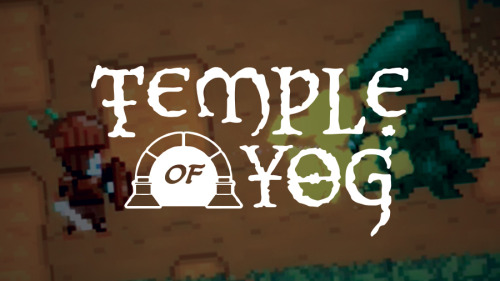
TEMPLE OF YOG is a 2D roguelike adventure about a village’s pact with a mysterious temple. Elders send tributes into the temple as sacrifice to unknown forces. These tributes fight and survive as long as possible until their timely demise. Once dead, the sacrifice is accepted and the village is rewarded with boons that advance their civilization. The better the sacrifice, the more boon awarded. Primitive huts and stone tools turn into castles, steel, and beyond.
Players are privy to the dual nature of this universe through the use of two displays unique to the Wii U console. The normal “world” is presented on the TV, while the otherly “shadow” manifestation is shown on the GamePad. The village and its inhabitants are represented on both displays, but in drastically different ways. Inside the temple, tributes must swap between these realms (and screens!) to navigate and conquer foes to the cause.
There are two game loops: the persistent village advancement loop (outer) and the procedural, permadeath-driven temple dungeon loop (inner). In the outer loop, players can level up various classes, stats, and equipment. The inner loop, on the other hand, has a predefined difficulty ramp and no inherent leveling system.
We wanted to playtest the inner dungeon loop and the core screen swapping mechanic. This feature is intrinsically tied to the Wii U and cannot be accurately experienced or measured on a different platform. We needed to observe how people adjust to using two screens, find where our difficulty curves were, and test the assumptions we’re making in development. We had to get people playing this on a Wii U, but our options were limited. The only way to get work-in-progress builds in front of an audience was to take it to them. So we did.
To bring in as many folks as possible, we decided to make an event out of our playtesting needs. We adjusted the game to fit an arcade experience and created social incentives and competition elements. Unique trophies and merchandise were provided to reward player participation. Most importantly, we showcased the people and culture behind the game through live music performances and artwork.
The inner dungeon loop is pretty compact. The experience is designed for 1 to 5 minutes of play. We added a point system that ranks up the player at different thresholds. This became a comparison point for people playing and created a vocabulary for dialog. Without the outer village loop however, the gameplay lacked a tangible progress component. There was monotony in our demo, and it was apparent after the first night.
While trapped in a Baltimore hotel during a mighty blizzard, we added environmental degradation to the inner loop. When players move up the ranks, the environment transitions from a lush green landscape to dead, thick brambles.

During the same frozen stay, we incorporated voiceover rank announcements a la Mortal Kombat’s “Fatality” proclamation. In keeping with DIY fashion, our composer Pieter Montoulieu recorded a quick and dirty track from Louie Castro-Garcia, our master of ceremonies, then crushed the bits and chipped the tunes.
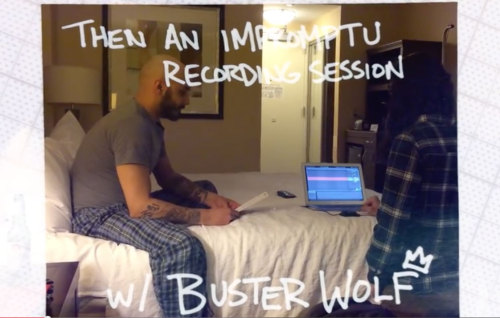
The audio was easily dropped into the demo and within 30 minutes we had a fun new element to our game. Huzzah for rapid development!
Every event needs merch. Lead artist Lee Bretschneider designed stickers, koozies, and pins for people to take away from our show.
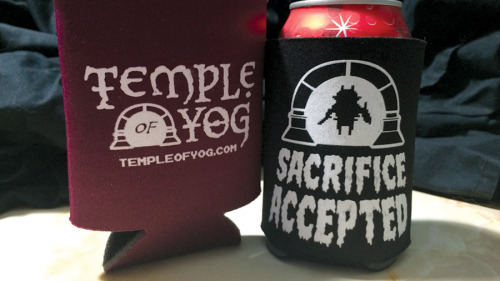
(There is nothing cooler than seeing your project in koozie form)
These trinkets were handed out as rewards for high scores each night. This little bit of competition went a long way for player engagement. Folks were battling throughout the event to topple their friends’ scores. It was pretty cool to see in action.
A great component we added to our event was live music. Pieter performed original chiptune music inspired by thrash metal and prog rock under the name Dr. Zilog (listen here!). He played songs from the TEMPLE OF YOG soundtrack and also his new album “Apothecary”.
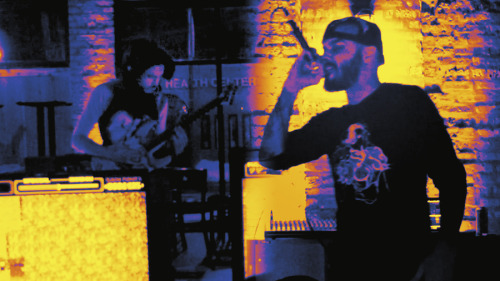
Louie is a phenomenal hiphop artist and MC. He orchestrated all the prize giveaways and performed as Buster Wolf (listen here!), a lyrical whirlwind touching on all things geeky, obscure, and sincere.
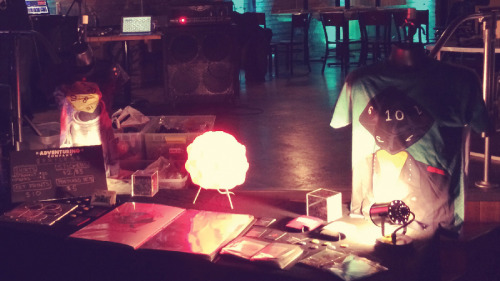
Lee brought his original artwork and designs to the table. From comics and illustrations to t-shirts and prints, people got to see what his banner Adventuring Company is all about.
These fine folks and the cultural artifacts they make gave each event the personal context needed to build community around the game. We designed an experience centered on gameplay, music, art, and prizes. This structure let collaborators in different communities customize each show to their audience. The next step was taking it on the road!
To recap:
We created an event that featured gameplay, music, art and prizes
We adjusted the game for a quick pick-up-and-play arcade experience
We improved the build along the way based on player feedback and observation
Rather than getting into the weeds of how we planned our tour, here’s the general gist of how to plan any tour:
Everyone agree on a timeframe
Plan a route that won’t make you go broke
Reach out to people ASAP
Stay in touch and follow every lead
Don’t be a shithead*
*most important rule
We decided to head out on tour Feb 19-27th across northeastern US & Canada. We started contacting folks for TEMPLE OF YOG Super Demo Tour dates 4 to 5 months in advance. After many many emails, texts, phone calls, cc’s, etc., our tour looked like this:
Tallahassee, FL: 621 Annex
Baltimore, MD: E.M.P. Collective
New York, NY: Babycastles
Toronto, ON: Bento Miso
Chicago, IL: Emporium @ Logan Square
Bloomington, IN: Rachel’s Cafe
This was before we left Tallahassee. Along the way up north, a blizzard dropped on Baltimore and the DC area, which meant our show was cancelled.
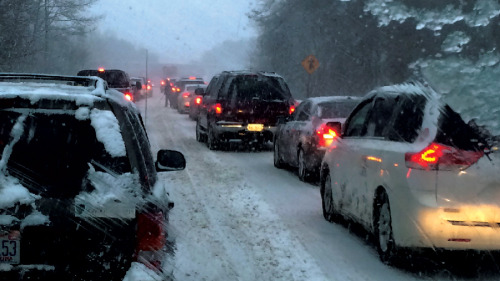
This happens when you tour, and it’s ok. Expect it will and keep cool when it goes down.
We added a stop while on the road too. There was down-time between New York City and Toronto, so Lee reached out to see if we could do a hop-on somewhere. It literally took 5 tweets and we had a show booked at Oogie Games in Buffalo, NY!
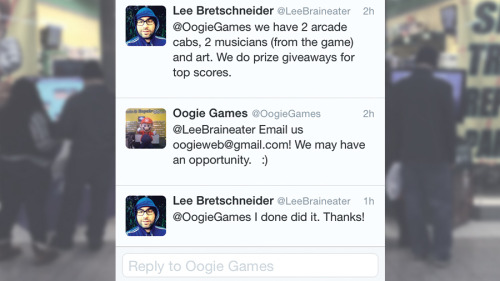
(Follow every lead!)
Moral of the story: try your hardest to book it right the first time, but be ok when things change. They will and you have to be ready to roll with it.
Everywhere you go, there will be game developers and enthusiasts. Finding them can be tricky, but an easy place to start is local IGDA chapters. Folks there are super helpful and generally quick about getting back to you. They might not be able to help personally set something up, but they can point you in the right direction. Same goes for any sort of co-working space or contemporary art gallery. The people dedicating their time to these entities are rad to the highest of fives.
Here’s a breakdown of the types of places we went to and how it went down:
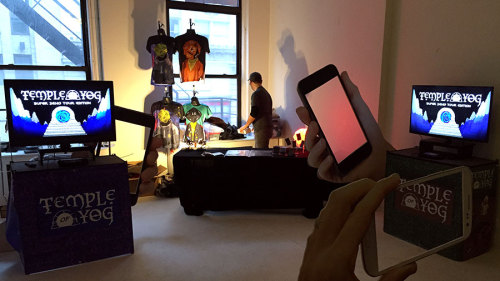
Good For:
High player engagement
Meaningful feedback
Community building
621 Annex, Babycastles, and Bento Miso are all some mixture of contemporary art gallery and co-working space. The people who went to these venues came because of genuine interest in the event. This made for a highly motivated audience giving deep and meaningful play sessions.
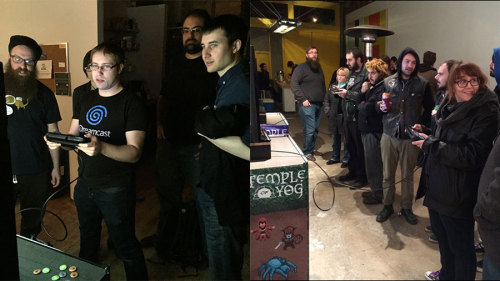
There was high engagement not only with the game, but the music and art around it. These spaces made for authentically fun nights.

Good For:
Kids!
Consumerfolk
Our retail experience consisted of a last-minute setup inside a Buffalo mall. Oogie Games specializes in used and vintage carts and consoles. It’s a cool store, but a space we weren’t best suited for. At times, we felt more like carnival barkers trying to entice stragglers at the fair.
(Metal Mario entices all)
But this spot has gold: kids! Children give the best honest feedback you could ever hope for. If they don’t like it, they will tell you right away. Same goes for your “average consumer” or whatever. People on a mission to buy stuff don’t have time for your bullshit. It was a quick study for us on cutting to the chase.
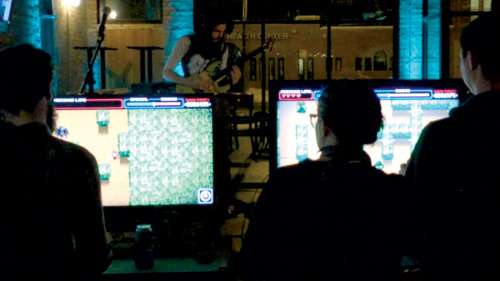
Good For:
Music & Art
Drinks
Bar Arcades are kind of a new thing I guess. They’re so popular in Chicago, there are like four all on the same street. We setup at Emporium @ Logan Square, and that place is awesome. It was good for music and drinks and getting people into the artwork, but not so much on the gameplay front. We were one in a sea of many blinking lights all fighting for attention.
But for real though, Emporium is super rad. Go there.
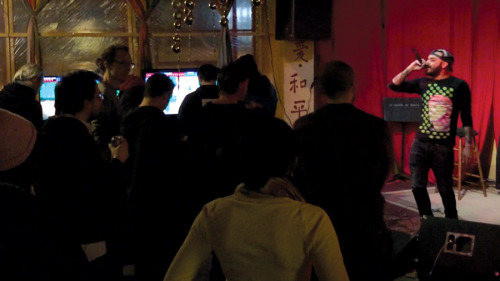
Good For:
Wildcard!
DIY spaces and houses are highly dependent on the people who run them for quality. We lucked out with Rick V who booked us a great night of music and games at Rachel’s Cafe, a coffee shop that has events after hours. We helped move all the chairs and tables to the back and setup along side other game developers from the area. Good times and good tunes.
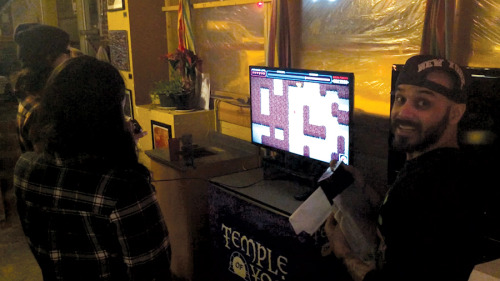
(Engagement was so high, we had to kick people off to finish breaking down)
So what made these events work? Like I mentioned before, we only had our little nugget. We collaborated with and had faith in the folks creating each night in their city to find an environment and make an experience that works for us and their community. Big thanks to the good peoples!
To Recap:
Start planning and contacting people well in advance, at least 4-5 months
Your route will change and that’s ok
Different venues have their own benefits
A lot of people out there are doing cool things, go find them!
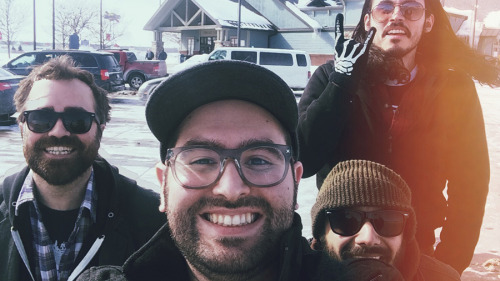
(YOG CREW: Cody, Lee, Pieter, Louie)
Touring is awesome and I highly recommend it, regardless of project. Getting as much input and feedback on what you are making during critical times is my favorite course of action. Things we never thought of came up. People gave us in depth recommendations. There were inquisitions on elements we thought were evident.
Your game has to leave the house sometimes.
If it doesn’t, it’s gonna get beat up on the first day of school.
And it should.
No game is perfect, but good games are battle tested.
Taking your game on tour is a gauntlet.
Our little nugget of a game got a ton of sunlight and bruises and smiles and crossed the rubicon a better idea.
***
Lee and I were walking down the street one night and talking about the creative process. We likened it cutting your way through a jungle in search of an oasis. Folks just hack away endlessly until they find their goal. Some never make it, and others stumble upon it by sheer luck.
We have a map.
Our focus moving forward is guided by good information and meaningful feedback culled from these events. We have tangible user stories to frame design decisions. Larger themes emerged during tour that now drive the development cycle. The foundation for dialog about the game has been set.
Touring made it helluva lot easier to see where we’re going.
- Cody
Read more about:
Featured BlogsYou May Also Like